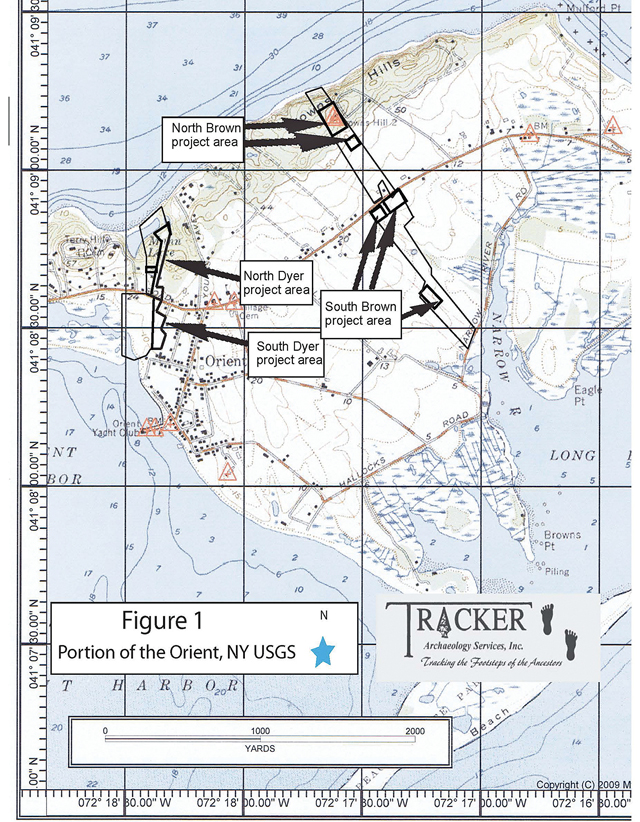Archaeological surveys revealed ‘historic remains’ at proposed subdivision

Closer Look podcast brought to you by:
The Southold Town Planning Board is moving forward cautiously with the proposed Tuthill conservation subdivision — four parcels totaling 112 acres in Orient — as archaeological research, evaluation and field testing continue to reveal multiple “historic remains” on the property.
Members of the Tuthill family, whose ancestors are believed to have arrived in Orient in 1640, own two parcels along Route 25 and another two along Narrow River Road in Orient. All four parcels are part of the family’s Oysterponds Holding Company and are used for agriculture and aquaculture as well as building lots that can be passed down across generations. The Tuthills are proposing that 94 acres of the property be preserved, while the remaining 18 acres be developed as 17 residential lots.
In 2011, Tracker Archaeology Services Inc. conducted a preliminary archaeological documentary study of the sites, known as a Phase 1A investigation, as part of the subdivision review process. The study, initiated by the applicant, supported by the Planning Board and required as part of the SEQRA process, was intended to determine the potential for recovery of prehistoric and historic archaeological remains on the properties.
“Orient has a high occurrence of archaeological sites to investigate,” assistant town planning director Mark Terry said Wednesday. “The applicant decided to conduct the surveys in 2011 and 2015. And it was at the Planning Board’s request in anticipation of needing that type of information for the SEQRA analysis. SEQRA assesses the potential agricultural impacts to cultural resources, including archaeological resources. Therefore, it’s usually necessary in the SEQRA process.”
While it didn’t come as a surprise that Native American trails were found, a variety of what Tracker Archeology classified as “remains” were also unearthed.
These discoveries present the Tuthills with a choice: They can either authorize more advanced archeological investigation of their properties or voluntarily reposition the potential building sites away from areas where artifacts have been found. If they proceed with the former, they will assume potentially significant costs. In addition, if any items found are deemed to have historical importance, the recovery, excavation and mitigation processes would take time, delaying the start of any residential development.
Landowners Reggie and Lyle Tuthill attended Monday night’s Planning Board work session, but declined to comment.
The 2011 investigation found that one of the four parcels, known as South Brown, had been the site of a five-acre Indian village, an area comprising several camps that existed about 600 years before European settlement. There, investigators discovered relics and shell midden and, on the plowed surface, more than 300 scrapers. Also found there were chipped stone tools and 51 other artifacts identified as “white quartzite fragments,” nine of which were also classified as tools.

At another parcel, called North Brown, more shell midden were found as well as what the Tracker report describes as a ”transitional-style burial with cremation, [an] artifact cache, red ochre [and a] possible bone bundle at deep level.” It is unclear whether any human bones were found and, if so, to whom they belonged.
“The state has given us indication that the Orient burial site may be on the northeast section of the North Brown parcel,” Mr. Terry said. “There’s no way to confirm the presence or absence without doing the Phase II investigation.”
Tracker’s 2011 report listed the properties as having “a high to higher than average potential for the recovery of nineteenth- to early twentieth-century Euro-American sites and a higher than average potential for Native American historic sites.”
In 2015, when Tracker conducted a Phase 1B survey “to provide physical evidence for the presence or absence of archaeological sites on the project area,” artifacts were again recovered at the South Brown site. Shovel tests conducted across the area at 15- to 17.5-meter intervals also found a prehistoric site along the North Brown bluff on Long Island Sound. Stone relief sculptures of Native Americans were discovered along the North Brown beach as were the remains of an early 20th-century brick and lumber building, known, according to the property owners, as the “House of Seven Gables.”
At an earlier Planning Board public hearing, Dr. Joel Klein, a local archaeologist, expressed concern about how the town and the property owners have handled the situation. He argued that the town was not giving the potential environmental impacts of development enough consideration.
Dr. Klein made the case that Tracker’s Phase 1B report “does not incorporate or consider the results of the Phase 1A investigation.”
Tracker Archaeology and officials from the state Office of Parks, Recreation and Historic Preservation are recommending that a Phase II investigation be conducted. This would require intensive testing and assessment involving a “neat plow,” or a deeper dig, that would allow investigators to interpret archaeological finds more closely and determine if any of the sites are eligible for placement on the National Register of Historic Places. Phase II would supply information about site integrity, cultural components or affiliations and time range present, vertical and horizontal distribution of archaeological remains and site interpretation.
“The discovery of a significant archaeological site, especially one which might contain human remains,” Dr. Klein said, “could render the parcel unusable, or usable only after a costly archaeological data recovery project.” Dr. Klein said in a March 2019 letter to the Planning Board that he is concerned his tax dollars may have to be spent defending potential legal challenges brought on by an inadequately overseen subdivision proposal.
Tracker’s principal investigator Alfred Cammisa will be contacting Tim Lloyd of NYS OPRHP, Mr. Terry said, to discuss the best way forward.








